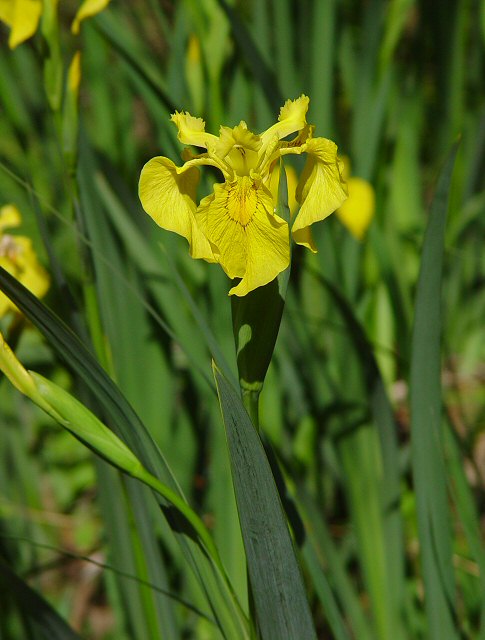Iris pseudacorus L.
Yellow Iris

Introduced
CC = *
CW = -5
MOC = 7
© DETenaglia
Iris pseudacorus L.Yellow Iris | |
 |
Introduced CC = * CW = -5 MOC = 7 |
© DETenaglia |
|
Family - Iridaceae Habit - Rhizomatous perennial forb. Rhizomes lacking conspicuously thickened areas.
Stems - Arching to erect, to 1.2 m, about as long as or somewhat shorter than the leaves.
Leaves - Basal and alternate on the aerial stems, 40-120 cm long, 10-30 mm wide, erect to more commonly arching or nodding near the tips.
Inflorescences - Terminal and axillary clusters of 2-3 flowers, the spathelike bracts unequal, 3-6 cm long, herbaceous, green.
Flowers - Sepals 5-8 cm long, spreading outward to arching downward, broadly obovate, with a longitudinal ridge, yellow, sometimes with irregular brown or purple markings along the ridge. Petals much shorter and narrower than the sepals, erect, yellow.
Fruits - Capsules 4-8 cm long, oblong-elliptic in outline, 3-angled, with a single rib at each angle.
Flowering - May - July. Habitat - Emergent aquatic, cultivated and rarely escaped to ditches, ponds, and small streams. Origin - Native to Europe. Lookalikes - None when flowering. Vegetatively nearly indistinguishable from I. virginica. Other info. - This striking species is widely cultivated in Missouri but is rarely escaped. There are scattered occurences across the continental U.S., but larger populations in the western parts of Oregon and Washington State. There, the plant is considered a noxious invasive and can form large populations in wetland areas. The plant has big yellow flowers and the inflorescences are shorter than or equal to the large leaves. This species has naked sepals, having no beard of modified hairs along their inner midveins. Photographs taken in Iron County, MO., 5-18-03, and in Auburn, AL., 4-17-05 (DETenaglia); also in Woodinville, King County, WA, 6-14-2015, and at Millstream Gardens Conservation Area, Madison County, MO, 5-21-2020 (SRTurner). |